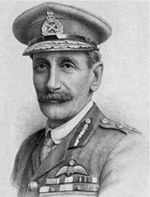David Henderson - Picture
More about World War 1

|
|
David Henderson
Place of birth: Glasgow, Scotland
Place of death: Geneva, Switzerland
Allegiance: United Kingdom
Service/branch: British Army, Royal Air Force
Rank: Lieutenant General
Commands held: 1st Infantry Division
Royal Flying Corps
Battles/wars: Second Boer War
Siege of Ladysmith
World War I
Awards: Knight Commander of the Order of the Bath
Knight Commander of the Royal Victorian Order
Distinguished Service Order
Other work: Director-General of Red Cross Societies
Second Boer War
Siege of Ladysmith
Lieutenant General Sir David Henderson KCB, KCVO, DSO, LLD (11 August 1862 - 17 August 1921) was an officer in the British Army who came to be considered as the leading authority on tactical intelligence during the early years of the 20th century. Henderson was also the first commander of the Royal Flying Corps in the field and was instrumental in establishing the Royal Air Force as an independent service.
Early and family life
David Henderson was born in Glasgow on 11 August 1862 into a shipping family. His father, also called David, was a joint owner of the Clydeside ship builders David and William Henderson and Company.
Henderson entered the University of Glasgow in 1877 at the age of just fifteen. While at university, Henderson read engineering and in his fourth year (1880-1881) he studied civil engineering and mechanics as well as office and field work in engineering, but failed to graduate.
In 1895, Henderson married Henrietta Caroline Dundas, later known as Dame Henrietta Henderson. She was a Dame of Grace, Order of St. John of Jerusalem (D.G.St.J.) and was knighted in 1919 as a Dame Commander of the Order of the British Empire (DBE). The couple had one son, Ian Henderson, who also joined the Royal Flying Corps, reaching the rank of captain. Ian Henderson predeceased his parents, dying in a flying accident in June 1918. Dame Henrietta Henderson died on 14 April 1959.
Military career

Picture - Gen David Henderson
Following officer training at the Royal Military College Sandhurst, Henderson was commissioned into the British Army on 25 August 1882. Henderson was a member of the Nile Expedition of 1898 and was wounded at the Siege of Ladysmith during the Boer War. In February 1901 Kitchener appointed Henderson his Director of Military Intelligence, a post he held until the end of the Boer War. Henderson's subsequent works Field Intelligence: Its Principles and Practice (1904) and The Art of Reconnaissance (1907) did much to establish his reputation as the Army's authority on tactical intelligence.
In 1911, at the age of 49, Henderson learned to fly, making him the world’s oldest pilot at that time. In 1913 the control of military aviation was separated from the responsibilities of the Master-General of the Ordnance. A new Department of Military Aeronautics was established and Henderson was appointed the first Director and, with the outbreak of World War I, he took up command of the Royal Flying Corps in the field. On 22 November 1914, Henderson was appointed General Officer Commanding the 1st Infantry Division and his Chief of Staff Frederick Sykes took up command in his stead. However, Henderson did not spend long commanding the 1st Infantry Division. The decision to post Henderson and replace him with Sykes was not to Lord Kitchener's liking and he ordered a reversal of the appointments. On 20 December 1914, Henderson resumed command of the Royal Flying Corps in the Field and Sykes was once again his Chief of Staff.
In 1915 Henderson returned to London to resume his London-based duties as Director-General of Military Aeronautics, which Sefton Brancker had been performing in his absence. This meant that when, in 1917, General Jan Smuts was writing his review of the British Air Services, Henderson was well placed to assist. Whilst seconded to General Smuts, Henderson wrote much of what came to be called the Smuts Report. It has been argued that he had a better claim to the informal title "father of the Royal Air Force" than Sir Hugh Trenchard. Trenchard himself believed that Henderson deserved the accolade.
In January 1918, Henderson was made a member of the Air Council, serving as its vice-president. However, having not been appointed as the RAF's Chief of the Air Staff, Henderson resigned from the Air Council in April, citing his desire to escape the atmosphere of intrigue at the Air Ministry.
Following his departure from the Air Council, Henderson returned to France where he served until October 1918. After the armistice, Henderson served as a military counsellor during the Paris Peace Conference until the signing of the Versailles Treaty in June 1919. Henderson then became Director-General of the League of Red Cross Societies in Geneva, where he died in 1921, aged 59.
Honours
Henderson was awarded the Distinguished Service Order in 1902 for his work during the Second Boer War.
In March 1918, Henderson accepted the honorary position of Colonel of the Highland Light Infantry.
More aircraft.
Source: WikiPedia